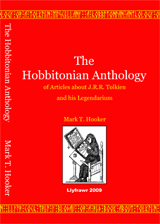Johannes Gutenberg-Universität Mainz
 |
The review of The Hobbitonian Anthology below appeared in Hither Shore, the German Tolkien Society's peer-reviewed annual. Volume #6 (2009), pp. 242-243. This book is another of Mark T. Hooker’s delightful collections of articles on various aspects of Tolkien’s works. A few of these are (revised) reprints from older publications, but most of the contents consist of new stuff. As you might expect by now, most are about Hooker’s main areas of interest. i.e., name studies and comparative Tolkien translation. The section on “Names” takes up around one third of the book. With the exception of a few rather short pieces, Hooker usually delves deeply into possible etymologies or literary sources/analogues for the names in question (among which are Bilbo, Boffin, Farmer Maggot, and Puddifoot), never being afraid of stepping off the beaten path and even introducing the occasional whimsical train of thought. He is fully aware that his analyses in places may run counter to Tolkien’s intentions stated by the man himself, but that never stops Hooker from engaging in his own line of enquiry. In these “Names” articles, the author displays a thorough knowledge of linguistics, etymology, and history, and is also very well versed with even obscure sources of literature. For instance. Hooker manages to trace the name Bilbo back to a French literary hero by the name of Bliboquet, and that of Tom Bomdadil to the sound of the bell in the Tom Tower of Christ Church, Oxford. Furthermore. Hooker also manages to transfer Tolkien’s concepts into other cultural identities, combing this with his intimate knowledge of many Tolkien translations to give us comments about the ways certain names and concepts have been translated, and often improvements aimed at translations that want to localize Tolkien’s names. His article on The Ivy Bush (short but to the point) is an excellent example of this approach: First there is an explanation of why exactly someone might want to call an inn thusly and then, we get a suggestion at how to arrive at a parallel way of naming that specifically fits German culture. This is excellent work. The second section is simply called “Many Things.” Its aim is to take a closer look at certain linguistic peculiarities of Tolkien’s works (like the term “nine days wonder” or the Hundredweight Feast), explain them in their English cultural context, and then look at ways of translating them. Of special interest here is an article on how people address one another in The Hobbit, and how this has been handled in various translations, based on the differentiation of the familiar vs. the deferential forms of address in the languages in question. The ensuing study is a must read for any student of comparative Tolkien translation. Section Three gives a short survey of all Hobbit translations Hooker is familiar with (we’re talking Belorussian, Bulgarian, Czech and Slovak, Dutch, German, Polish, Russian, Serbian, and Ukrainian here!), listing things that stand out, obvious mistakes, innovative solutions, and the like. While not of equal use to everyone, this is a valuable repository of sage translatorial advice and comment. Section Flour is somewhat more specialized, dealing with the Russian translations of Leaf by Niggle. All in all, this book is a highly interesting and worthwhile read for anyone interested in speculating about how and why Tolkien used language the way he did, and it is invaluable for someone interested in Tolkien translation. Even if you already know much about these subject, you are bound to learn quite a few new things and/or find that new vistas for research have opened up for you. Rainer Nagel |
